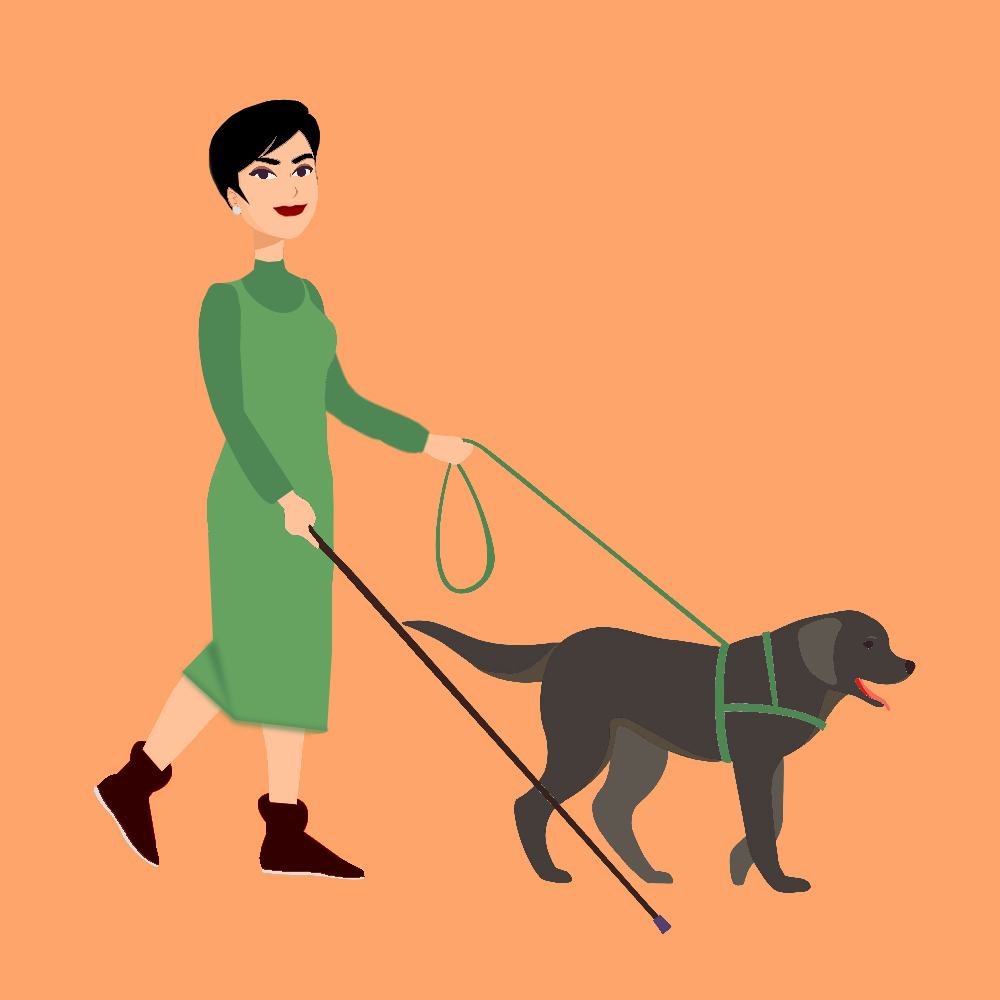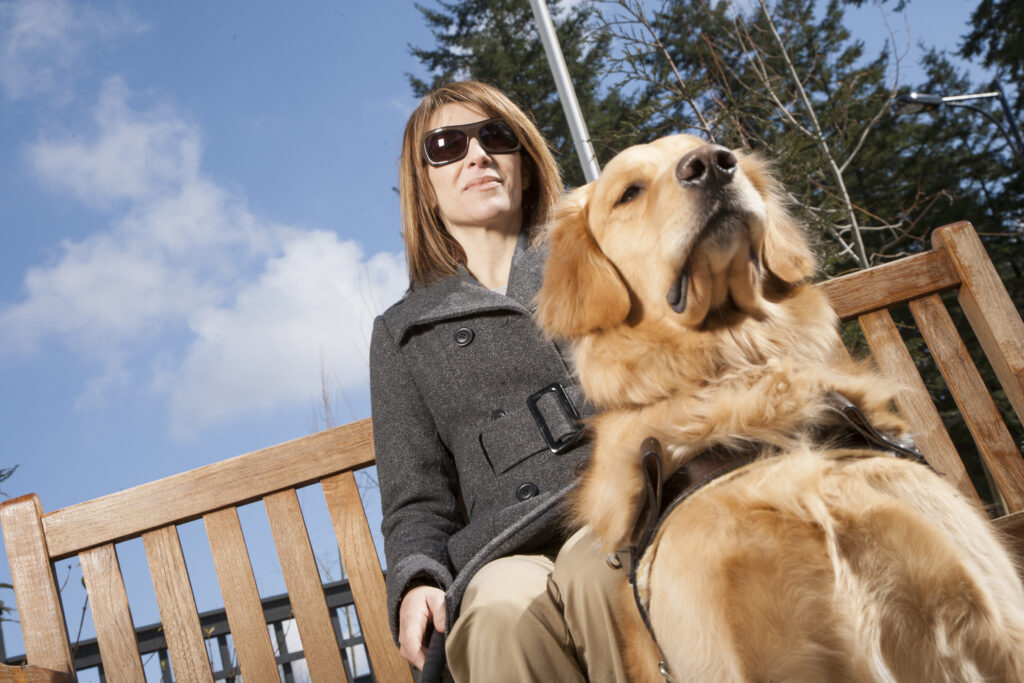Some people with disabilities use service animals at work to assist them with a variety of tasks. For example, someone with a severe vision impairment may rely on a guide dog for navigation in the workplace; a person who is deaf may receive assistance from a hearing or signal dog; someone with a seizure disorder may rely on a dog trained in seizure warnings and response; and someone with a psychiatric disability may rely on a psychiatric service dog for a variety of tasks, from soothing the effects of PTSD to interrupting the person’s self-destructive behavior. If you have a service dog or “emotional support animal,” read on to learn your workplace rights under the Americans with Disabilities Act (ADA).

Under the part of the ADA that applies to public accommodations, a service animal is defined as a dog (or sometimes a miniature horse) that is individually trained to perform tasks or do work for the benefit of a person with a disability. This definition doesn’t include companion animals (pets), nor does it include what some call “emotional support animals”: animals that provide comfort and companionship to those with psychiatric or emotional disabilities or conditions. Although these animals often have therapeutic benefits, they are not individually trained to perform specific tasks for their handlers. Under the ADA, owners of public accommodations are not required to allow emotional support animals, only service animals.
The part of the ADA that applies to employment, however, does not use these same definitions; in fact, this part of the ADA doesn’t define “service animals” at all. Under the employment discrimination sections of the ADA, an employer may simply be required to allow an employee to use a service dog at work as a reasonable accommodation for the employee’s disability. An employer may also have to consider allowing an employee to use an emotional support or other assistance animal, if the employee requires the animal as a reasonable accommodation for a disability. (Under the ADA, employees with disabilities are entitled to reasonable accommodations that will allow them to do their jobs, unless it would create undue hardship: significant expense or burden, given the size and resources of the employer.)
Requesting a Reasonable Accommodation to Bring an Animal to Work
If you need an accommodation to do your job, you must request one. It’s best to put your request in writing, so you have a record of when you asked for an accommodation and what information you provided to your employer. In your letter, describe your disability and how it affects you. Explain that you would like to bring a service dog or assistance animal to work as an accommodation, and describe how the animal will assist you in performing your job. Describe how your animal has been trained and the tasks or work the animal does (for example, pulling your wheelchair, assisting you with manual tasks, or alerting you to the onset of a seizure). You may also want to describe how you will care for the animal at work, including where the animal will be and how the animal’s needs will be met. Your employer can request documentation of your need for the animal, the animal’s training and duties, and the animal’s good behavior. It’s also important to know, that under the Americans With Disabilities Act (ADA), people with disabilities are allowed to be accompanied by their guide and service dog in all places the public is permitted.
15 Service Dog Etiquette Tips in the Workplace
- Please don’t touch, talk, feed or otherwise distract the dog while he is wearing his harness or vest. You should allow the dog to concentrate and perform for the safety of his handler.
- Don’t treat the dog as a pet; give him the respect of a working dog.
- Speak to the handler, not the dog. Some handlers will allow petting, but be sure to ask before doing so. If allowed, don’t pat the dog on the head, stroke the dog on the shoulder area.
- You should not give the dog commands; allow the handler to do so.
- Guide and service dog teams have the right of way.
- Don’t try to take control in situations unfamiliar to the dog or handler, but please assist the handler upon their request.
- When walking with a guide or service dog team, you should not walk on the dog’s left side, as it may become distracted or confused. Ask the handler where you should walk. Depending on the situation, they may ask you to walk ahead of them on their right side, or behind them by their right shoulder.
- Never attempt to grab or steer the person while the dog is guiding or attempt to hold the dog’s harness. You should ask if the handler needs your assistance and, if so, offer your left arm.
- Try not to be over-protective or overbearing when the graduate first arrives home with the new dog. Be thoughtful, patient, and try to inspire confidence in the handler. In time, you will admire the expertise of the team.
- Don’t expect too much too soon, remember, the dog is young and that complete harmony and confidence takes patience, perseverance, and time.
- Never give the dog table scraps. You should respect the handler’s need to give the dog a balanced diet, and to maintain its good habits.
- Don’t allow anyone to tease or abuse the dog, allow it to rest undisturbed.
- Make sure not to allow your pets to challenge or intimidate a guide dog. You should allow them to meet on neutral ground when all parties can be carefully supervised.
- A guide and service dog should not jump on furniture or go in areas of a home not mutually agreed upon by the family or handler. You can ask the handler to correct any errant behavior or trespassing.
- Never let the dog out of the house unsupervised, and be sure that all doors and/or gates are closed to prevent the dog from exiting your property.
Guide dogs are the guiding eyes for people who are blind or visually impaired. Service dogs are assistance dogs for people with disabilities other than blindness. These dogs are specially bred and trained for this most important job. There are several guidelines people should follow when in the presence of a guide or service dog to allow for the safety of the dog and its handler. Disregarding these guidelines can distract the dog, which can create a dangerous situation for the dog and its handler. For more information on the use of service dogs in the workplace click here
.

